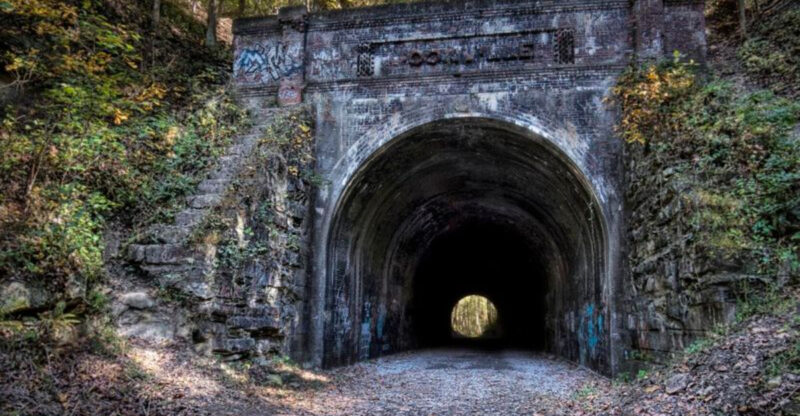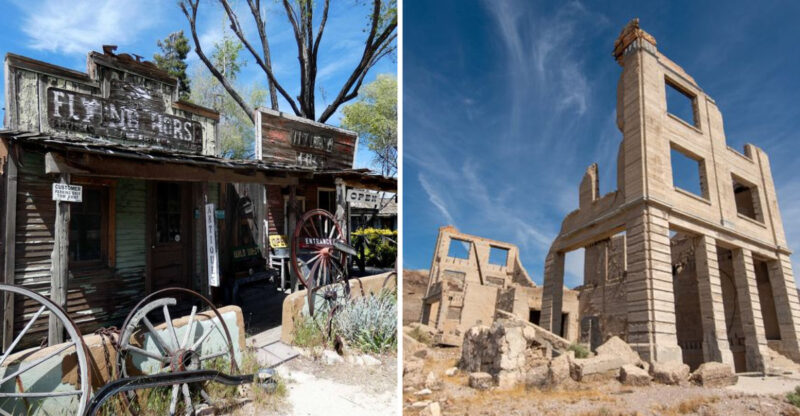10 Abandoned Pennsylvania Railroads Nature Is Slowly Taking Back

Pennsylvania’s rich railroad history left behind miles of forgotten tracks and crumbling stations. Where iron horses once thundered through valleys and mountains, nature now quietly reclaims its territory.These abandoned rail lines tell stories of industrial glory and changing times, while offering glimpses into how wilderness transforms human-made landscapes into something entirely new.
1. Switchback Railroad – Jim Thorpe
Built in 1827 to haul coal down Mauch Chunk Mountain, this gravity-powered railroad became America’s first rollercoaster attraction. Visitors paid to ride the thrilling descent before mules pulled cars back uphill.
Sections of the original track bed still wind through dense forests near Jim Thorpe. Stone foundations peek through thick undergrowth, while saplings push between weathered ties that once guided coal cars downward at breathtaking speeds.
2. Enola Low Grade Line – Lancaster County
Freight trains rumbled along this Pennsylvania Railroad branch for decades, connecting Enola Yard to Columbia. The line crossed Lancaster’s Amish countryside, carrying goods between major distribution points.
Today, wildflowers blanket the former rail bed in spring. Old bridge abutments stand silent among cornfields, their concrete slowly cracking as tree roots work through foundations, creating homes for woodland creatures seeking shelter.
3. Ghost Town Trail – Cambria And Indiana Counties
Coal mining communities thrived along this Ebensburg & Black Lick Railroad route before economic shifts emptied entire towns. The railroad served mines and villages that vanished when anthracite demand collapsed.
A 36-mile trail follows the former rail bed through forgotten settlements. Cyclists pass concrete foundations where homes once stood, while blackberry bushes grow wild around abandoned tipples. Nature softens the industrial scars left behind.
4. Lehigh Valley Railroad – Along The Lehigh River
Known as the Route of the Black Diamond, this railroad hauled anthracite coal from Pennsylvania’s mines to eastern markets. Passenger trains also carried travelers through scenic river valleys between Wilkes-Barre and Easton.
Sections remain abandoned along the Lehigh River, where rails rust beneath invasive vines. Station buildings stand empty in small towns, their windows broken and platforms crumbling as weather and vegetation slowly erase traces of bustling railroad activity.
5. Pennsylvania Main Line Canal & Railroad Corridor – Between Harrisburg And Pittsburgh
This engineering marvel once combined canals and railroads to cross the Allegheny Mountains, moving goods between eastern and western Pennsylvania. The Portage Railroad featured inclined planes that lifted canal boats over mountain ridges.
Portions of the old alignment lie forgotten in remote valleys. Stone culverts channel streams beneath vanished tracks, while embankments slowly erode. Forest reclaims sections where locomotives once struggled uphill, their whistles echoing through mountain passes.
6. East Broad Top Railroad – Rockhill Furnace
Narrow-gauge trains served coal mines and iron furnaces from 1873 until operations ceased in 1956. The railroad preserved much of its original equipment, creating an unintentional time capsule of steam-era railroading.
Though portions operate seasonally for tourists, long stretches remain untouched. Rusting locomotives sit in overgrown yards while saplings grow between tracks. Wooden trestles weather slowly, their timbers gray and moss-covered, waiting patiently amid encroaching wilderness.
7. Erie Railroad – Northwestern Pennsylvania
Connecting New York to Chicago, the Erie Railroad passed through Pennsylvania’s northwestern counties, serving industrial towns and agricultural regions. Freight and passenger trains traveled this route for over a century before consolidation reduced service.
Abandoned sections hide beneath second-growth forests near the New York border. Crossing signals lean at odd angles, their mechanisms frozen. Deer paths cross former tracks where sumac and wild grape vines tangle around forgotten mile markers.
8. Pine Creek Railroad – Tioga County
Loggers relied on this narrow-gauge railroad to transport timber from Pennsylvania’s Grand Canyon region during the lumber boom. Steam locomotives chugged alongside Pine Creek, hauling massive logs to distant sawmills.
The corridor now forms part of a recreational trail system. Hikers walk where locomotives once labored, passing rusted spikes and occasional rail fragments. Hemlocks and birches reclaim the right-of-way, shading the path through spectacular canyon scenery.
9. Schuylkill Branch (Pennsylvania Railroad) – Philadelphia To Pottsville
Coal from Schuylkill County mines traveled this branch line toward Philadelphia markets and port facilities. The railroad followed the Schuylkill River through industrial towns that boomed during Pennsylvania’s coal era.
Urban sections disappeared beneath redevelopment, but rural stretches remain abandoned. Rails poke through asphalt where roads crossed former tracks. Brick signal towers stand empty beside overgrown sidings, their windows dark and doors hanging loose on rusted hinges.
10. Western Maryland Railway – South Of Connellsville
This railroad served coal mines and coke ovens in southwestern Pennsylvania, connecting industrial operations to larger rail networks. Trains hauled raw materials and finished products through Appalachian foothills.
Abandoned sections wind through forests south of Connellsville. Stone bridge abutments stand where spans once carried trains across valleys. Wildflowers bloom along former rail beds each spring, while groundhogs burrow beneath rotting ties that slowly decompose into forest soil.






